Teaching Kids to Ski Behind a PWC
PWC make ideal teaching vehicles
This summer, a lot of the same things will happen that have happened every summer for decades. People will get sunburns, friends and relatives will get together for a barbecue, people will flock to the water…and countless kids will learn to ski for the very first time. Like the others I mentioned, it’s a given, a summertime rite of passage.
What does this have to do with personal watercraft? Well if you own one, you own one of the best boats — bar none — for introducing kids to skiing.
If you’re wondering why, let me count the ways. For starters, PWC are relatively affordable. That puts one in the reach of many more families than your average motorboat. But perhaps more importantly, PWC are far less intimidating to a child.
Think about it. You’re a kid, and your parents are on a boat, behind a transom 70 feet away, a whirling prop between you and them. They’re almost enclosed away from you, and you’re vulnerable in the water. And once that boat accelerates, it puts up a whopper of a wake that, in your eyes, is just waiting to knock you down. That’s how many kids view the process.
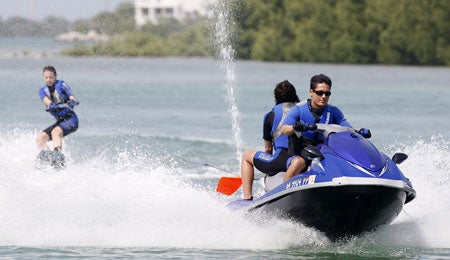 A small, nimble PWC is a great vehicle to teach a child to ski with.
A small, nimble PWC is a great vehicle to teach a child to ski with.Now contrast that experience with a PWC. That same parent is sitting backwards on the seat of a much smaller boat, fully in your view. Below them, an enclosed jet never threatens to do you harm. Once you’re up and going, that smaller PWC puts up a much more manageable wake, and a careful hand on the throttle will never jolt you out of the water the way a larger engine can.
And should you fall, that nimble PWC will get right back to you in a flash. No big curving banks, no settling in the water. A PWC is quick, and will be back to assist in just seconds.
That’s a comforting thought to a beginning skier.
The Process
So you’ve already got the ideal tow vehicle, which only leaves some basic items. While they may quickly develop other favorites, most kids start with a learner’s set of combo skis. These are proportioned to a kid’s size, and can be linked together via a small rope or rigid stabilizer bar. That keeps the skis together and avoids the common mishap of a child, with less leg muscle, doing the splits. Most ski manufacturers make them. Check out your local dealer, or look at catalog sites like Overtons or West Marine. Beyond a combo set of beginner skis, all you need is a towrope. A basic 75’ standard line will do.
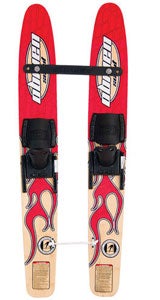 Scout trainer combo skis.
Scout trainer combo skis.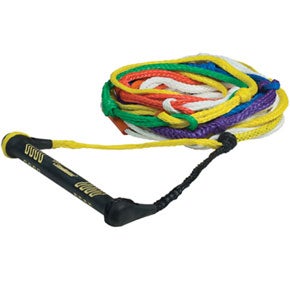 Gladiator Pro Champ handle with 75′ line.
Gladiator Pro Champ handle with 75′ line.Some of the best advice I’ve ever received is to start your child on a wet lawn before they hit the water. Get them in the skier’s position with skis on, holding the towrope, their bottoms sitting atop the back of the skis. Now you, as their instructor, pull them up and into position. The goal is for the child to let you do the work, and get the feel for the pull of a towboat, rather than try to muscle their body up into position.
Once they’ve got the feel of the pull, take it to the water.
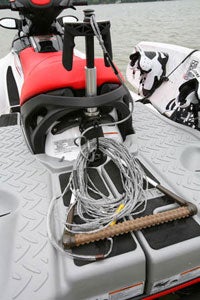 Ski-Doo’s Wake line of watercraft come with a retractable ski pylon.
Ski-Doo’s Wake line of watercraft come with a retractable ski pylon.Make sure the driver is a skilled PWC operator. That way they can feather the reverse to avoid a sudden jolt as the skier is getting into position, and accelerate with a smooth finger on the throttle. Remind the driver to keep their lines as straight as possible, and arc through gradual, controlled turns. Now’s not the time to strut your PWC’s handling skills. Smooth, steady, and predictable are the key thoughts to keep in mind.
If your child is unsure, put an adult in the water to help. He or she can move the child into the proper position — knees tucked up toward the chest, arms straight, skis parallel — then place their hands under the child’s thighs to help them hold it. When the rope is tight and the child ready, that helper can offer one last-minute reminder (“arms straight, knees bent, let the boat pull you”), then help guide the skier into position as the boat accelerates.
Remember, encouragement is vital. If the child falls, keep up the praise, offering suggestions on how to improve but never taking the fun out of the process. Common falls can be quickly addressed. If the child falls backward, they’re likely pulling in on the rope. Remind them to keep the arms straight, and let the PWC do the work of pulling. If they go over the front, they’re not maintaining their position. Again, give a quick reminder to stay centered, with knees bent and arms straight.
Once the child is up, keep the first ride short. Many kids get scared the first time they are pulled suddenly into unfamiliar, deeper waters. The helper can stay in the water, and quickly be at the child’s side once they return and release the handle to stop.
Just The Beginning
Skiing will likely never replace riding your PWC as the kids’ main form of enjoyment. It is, however, just one more way to keep them involved, a fun activity that the family can enjoy together.
And once your kids are up, the possibilities are vast — wakeboarding, wake skating, slalom skiing, kneeboarding, there are countless new challengers waiting to be mastered.
And as every parent out there will agree, countless new memories to be shared long after the summer’s warmth has faded.
Get PersonalWatercraft.com in your Inbox!
Like PersonalWatercraft.com on Facebook
Comments
Most Popular

Remembering the Sea-Doo XP

2025 Yamaha JetBlaster PRO 2-Up Review

2024 Yamaha GP HO Review

2024 Kawasaki Jet Ski STX 160X Review

2017 Kawasaki Jet Ski Ultra 310LX Review
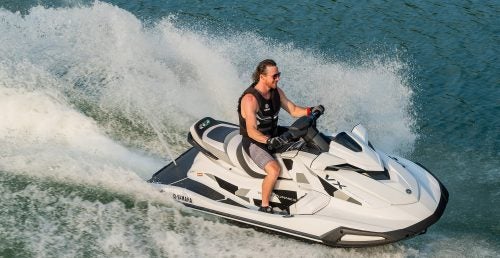










 Your Privacy Choices
Your Privacy Choices